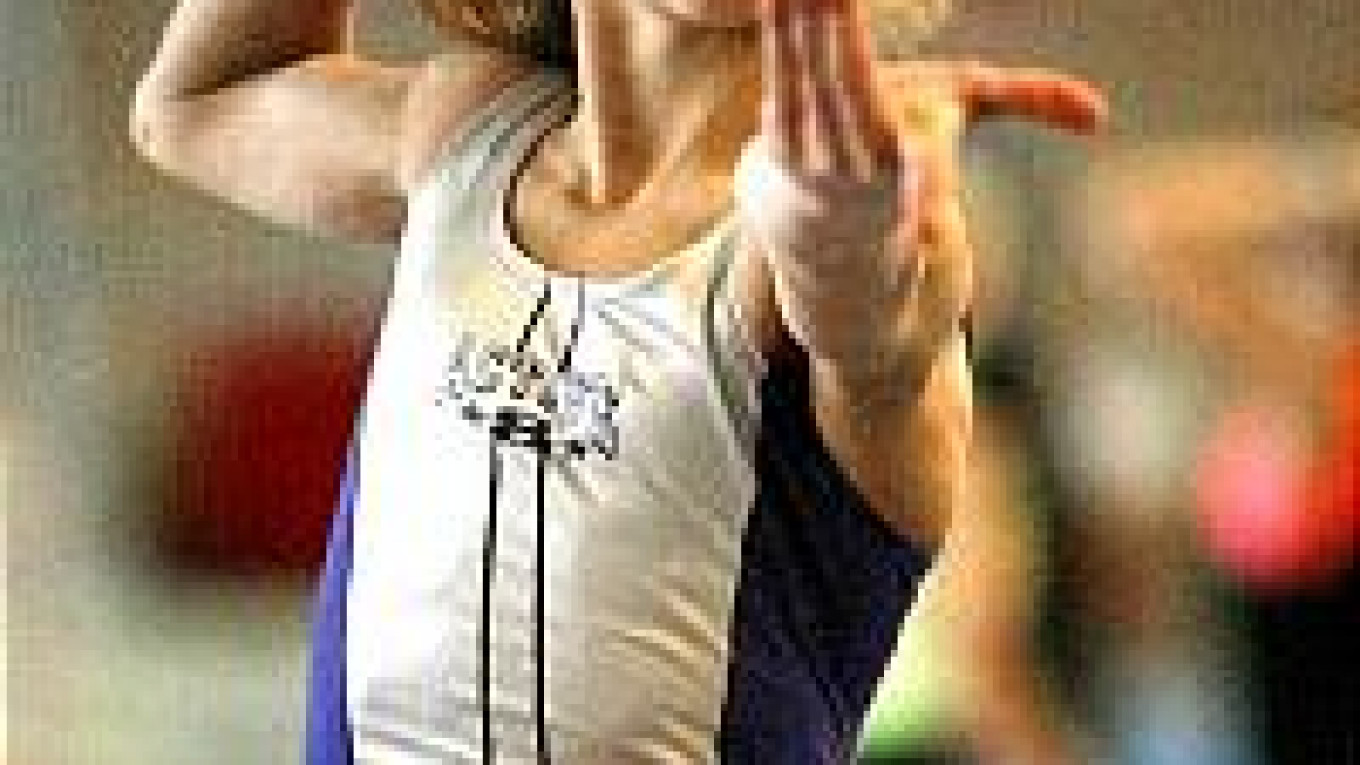Her deliberate belly-flop sent a chalk cloud flying into the thin winter light filtering through the gym's windows. It was the third time in 10 minutes that Miller had repeated the surprisingly graceful exercise.
"Beautiful, isn't it?" her coach Natalya Kovrizhnykh said as Miller wordlessly picked herself up and climbed back onto the bars to do it again.
"They have to have a real wish to do this. No one is making them be here," Kovrizhnykh added.
Russia has long been a powerhouse in women's gymnastics, in large part due to the drive of girls like Miller. She moved away from her family in St. Petersburg when she was 12 and has made gymnastics her life.
But while the Russian gymnasts had an impressive medal haul at the 2000 Summer Games in Sydney, the team's traditional dominance was called into question by a disappointing performance at the World Championships in Debrecen, Hungary, in late November. Trainers play down any worries but nonetheless say the future depends largely on a group of pre-teens including Miller who will enter "adult" competition in 2003. They are confident this new generation will be ready in time for the 2004 Olympics in Athens.

| |
The Soviet gymnastics machine still functions at Krugloye Ozero, a bunker-like sports center past Sheremetyevo Airport some 30 minutes' drive outside of Moscow, where the national team has trained since 1971. The complex takes its name from nearby Krugloye Ozero, or Round Lake, and consists of men's and women's gyms, a dormitory, a dining hall and administrative offices. Gymnasts as young as 9 move to the training center from all over Russia.
The mood at Krugloye Ozero was subdued after the World Championships, where reigning world champion Svetlana Khorkina fell from the bars while executing her signature move, dropping her out of medal contention on her best apparatus for the first time since 1997. Yelena Zamolodchikova won on the vault, but the Russian women's performance was a far cry from their strong showing two years ago in Sydney. There, Khorkina took silver in the floor exercise and gold on the uneven bars, Zamolodchikova won gold on the floor, and Yekaterina Lobaznyuk and Yelena Produnova claimed silver and bronze, respectively, on the balance beam. Krugloye Ozero senior trainer Marina Boloshenko said no one should read too much into the poor results. "It was Khorkina's third day on the bars, of course she was tired. It does not mean a thing for Russian gymnastics," said Boloshenko. "And we are very happy about Zamolodchikova's victory on the vault."
With all thoughts now turning to Athens, the trainers at the moment can predict only three of the gymnasts most likely to make the six-member squad: Khorkina, Zamolodchikova and Natalya Ziganshina. Khorkina, however, may not make it through another year. A 23-year-old who lives in a coveted single room at Krugloye Ozero, she is already a pensioner by gymnastics standards and has other interests, including modeling and acting.
In January 2003, according to Federation of International Gymnastics rules, girls born in 1988 will become eligible for the gymnastics big leagues. Among others, major Russian standouts on the youth circuit -- Miller, Yelena Anoshina and Maria Kryuchkova -- and Anna Pavlova, who turned 15 this year, will start to vie for spots on the team for next year's World Championships, seen as a dress rehearsal for Athens. Boloshenko directs two practices per day during which all of Krugloye Ozero's roughly 20 resident female gymnasts work out.
Each gymnast has a trainer who moved with her from her home city and watches her practice. Trainers can return home on weekends to check in on the progress of their home gym's younger members, but if a star protege is admitted to Krugloye Ozero, they also must leave their families and move into the dorm. Each day, twice a day, Boloshenko makes the rounds among the gymnast-trainer pairs, shouting commands, lifting small legs higher and forcing toes to point.
"Ivanova, come here," Boloshenko called out to a 12-year-old gymnast who looked half her age. Katya Ivanova, who has muscled legs, huge eyes and frizzy hair pulled back in a ponytail, ran over. "Show what pretty gymnasts I have. What is beauty in a gymnast? They are all beautiful in their own way."
Ivanova struck a pose and held it while Boloshenko continued to talk.
She explained that the Russian gymnastics community has been weakened by emigration and under-funding since 1991, but perseveres with the mania-like devotion that characterized the sport throughout the Cold War.
During that period, the Soviet government committed considerable resources to channel Russia's ballet traditions into gymnastic dominance. Russia's first gymnastics hall was opened on Strastnoi Bulvar in Moscow in 1881, but the sport really took off after World War II. In 1949, the Soviet Union joined the Federation of International Gymnastics. At the 1952 Olympic Games, the Soviet gymnasts made their presence known; the men's and women's teams left Helsinki with 12 gold medals. Head coach Leonid Arkayev has led the team since 1971, providing stability during periods of tumult.
"The system of gymnastics has not changed very much at all since the end of the Soviet Union because it is based on very old training principles," said Anoshina's coach, Tatyana Fomkina.
Those training principles, which boil down to starting younger and training harder, are now widely emulated in gymnastics powerhouses like China and the United States. Decades ago, however, when the Eastern Bloc began pumping out teenage dynamos like Olga Korbut and Nadia Comaneci, who dazzled the world with their acrobatics, the United States was fielding older gymnasts with more elegance than athleticism. The United States also has benefitted from some of the Soviet Union's most talented trainers, like Tatyana Perskaya, who emigrated for better pay.
Olga Sagina, Kryuchkova's trainer from Rostov-on-Don, earns $100 a month. Contracts are different in every city depending on how much the gymnastics federation allocates, but Sagina's wage is fairly typical. Trainers earn money based on their standouts' performances in competitions and the size and potential of their group back home.
Boloshenko said funding for the Krugloye Ozero facility is just enough. The gymnastics federation pays for gymnasts' room and board, but parts of the gym and dormitory are in dire need of cosmetic repairs.
This year, the men's gym will be renovated, but the women's half will have to wait. In the women's two halls, the floorboards creak and wallpaper hangs down in strips in an unpainted locker room with only two showers for all the female gymnasts.
Krugloye Ozero also lost much of its talent pool when the Soviet Union crumbled. Ukraine, Belarus and Uzbekistan traditionally provided the Soviet team with strong gymnasts, but now their athletes compete under different flags.
"It was very hard to make the team during the Soviet Union. Think -- only six people on the team, and gymnasts from Ukraine, Belarus and Uzbekistan," said Sagina. "Now that it is just Russian gymnasts, competition is a bit less, but still tough."
Kovrizhnykh regularly tours kindergartens looking for children with the right physique: thin, muscled limbs, natural grace and a pretty face. She then invites them to train for a few years in her St. Petersburg gym and sends most home in the end. If a child is particularly talented, a trainer will bring her to Krugloye Ozero for two to three weeks when she is 9 or 10 years old to be evaluated by Arkayev and Boloshenko.
One such hopeful is 9-year-old Ira Sazunova, who traveled from Vologda with her trainer for a chance to impress Boloshenko. The plucky youngster with blond pigtails fastened at lopsided angles atop her small head tried over and over to land a front flip on the balance beam, but wobbled or fell each time while her trainer looked on silently.
Boloshenko had not made it over yet to evaluate Sazunova in the two days she had been training at Krugloye Ozero. "There are so many young gymnasts," Boloshenko said, a bit exasperated. "And they are the future of the sport."
She then turned to her next task: a freckled 12-year-old hanging in a harness from the ceiling. Boloshenko asked the child to straighten her legs and fold her arms across her chest; Boloshenko then grabbed the gymnast solidly by her shoulders and knees and started to rotate her faster and faster in front flips. The gymnast obediently bit down on her lip, and her eyes started to roll to the ceiling dizzily.
A Message from The Moscow Times:
Dear readers,
We are facing unprecedented challenges. Russia's Prosecutor General's Office has designated The Moscow Times as an "undesirable" organization, criminalizing our work and putting our staff at risk of prosecution. This follows our earlier unjust labeling as a "foreign agent."
These actions are direct attempts to silence independent journalism in Russia. The authorities claim our work "discredits the decisions of the Russian leadership." We see things differently: we strive to provide accurate, unbiased reporting on Russia.
We, the journalists of The Moscow Times, refuse to be silenced. But to continue our work, we need your help.
Your support, no matter how small, makes a world of difference. If you can, please support us monthly starting from just $2. It's quick to set up, and every contribution makes a significant impact.
By supporting The Moscow Times, you're defending open, independent journalism in the face of repression. Thank you for standing with us.
Remind me later.


